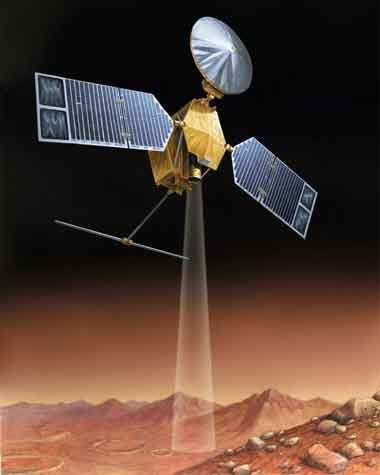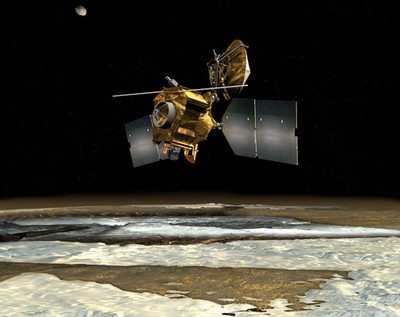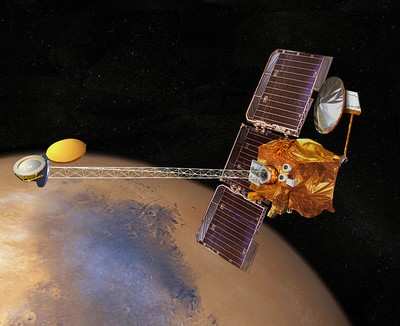CO2 Varies Greatly As Planet's Axis Shifts
NASA's Mars Reconnaissance Orbiter (MRO) has discovered the
total amount of atmosphere on Mars changes dramatically as the tilt
of the planet's axis varies. This process can affect the stability
of liquid water if it exists on the Martian surface and increase
the frequency and severity of Martian dust storms.

NASA Graphic
Researchers using MRO's ground-penetrating radar identified a
large, buried deposit of frozen carbon dioxide, or dry ice, at the
Red Planet's south pole. The scientists suspect that much of this
carbon dioxide enters the planet's atmosphere and swells the
atmosphere's mass when Mars' tilt increases. The findings are
published in a report in the journal Science.
The newly found deposit has a volume similar to Lake Superior's
nearly 3,000 cubic miles. The deposit holds up to 80 percent as
much carbon dioxide as today's Martian atmosphere. Collapse pits
caused by dry ice sublimation and other clues suggest the deposit
is in a dissipating phase, adding gas to the atmosphere each year.
Mars' atmosphere is about 95 percent carbon dioxide, in contrast to
Earth's much thicker atmosphere, which is less than .04 percent
carbon dioxide.
"We already knew there is a small perennial cap of
carbon-dioxide ice on top of the water ice there, but this buried
deposit has about 30 times more dry ice than previously estimated,"
said Roger Phillips of Southwest Research Institute in Boulder, CO.
Phillips is deputy team leader for MRO's Shallow Radar instrument
and lead author of the report.

"We identified the deposit as dry ice by determining the radar
signature fit the radio-wave transmission characteristics of frozen
carbon dioxide far better than the characteristics of frozen
water," said Roberto Seu of Sapienza University of Rome, team
leader for the Shallow Radar and a co-author of the new report.
Additional evidence came from correlating the deposit to visible
sublimation features typical of dry ice.
"When you include this buried deposit, Martian carbon dioxide
right now is roughly half frozen and half in the atmosphere, but at
other times it can be nearly all frozen or nearly all in the
atmosphere," Phillips said.
An occasional increase in the atmosphere would strengthen winds,
lofting more dust and leading to more frequent and more intense
dust storms. Another result is an expanded area on the planet's
surface where liquid water could persist without boiling. Modeling
based on known variation in the tilt of Mars' axis suggests
several-fold changes in the total mass of the planet's atmosphere
can happen on time frames of 100,000 years or less.
The changes in atmospheric density caused by the carbon-dioxide
increase also would amplify some effects of the changes caused by
the tilt. Researchers plugged the mass of the buried carbon-dioxide
deposit into climate models for the period when Mars' tilt and
orbital properties maximize the amount of summer sunshine hitting
the south pole. They found at such times, global, year-round
average air pressure is approximately 75 percent greater than the
current level.

"A tilted Mars with a thicker carbon-dioxide atmosphere causes a
greenhouse effect that tries to warm the Martian surface, while
thicker and longer-lived polar ice caps try to cool it," said
co-author Robert Haberle, a planetary scientist at NASA's Ames
Research Center in Moffett Field, CA. "Our simulations show the
polar caps cool more than the greenhouse warms. Unlike Earth, which
has a thick, moist atmosphere that produces a strong greenhouse
effect, Mars' atmosphere is too thin and dry to produce as strong a
greenhouse effect as Earth's, even when you double its
carbon-dioxide content."
The Shallow Radar, one of MRO's six instruments, was provided by
the Italian Space Agency and its operations are led by the
Department of Information Engineering, Electronics and
Telecommunications at Sapienza University of Rome. NASA's Jet
Propulsion Laboratory in Pasadena, CA, manages the MRO project for
NASA's Science Mission Directorate at the agency's headquarters in
Washington. Lockheed Martin Space Systems in Denver built the
spacecraft.
 ANN's Daily Aero-Linx (04.16.24)
ANN's Daily Aero-Linx (04.16.24) Aero-News: Quote of the Day (04.16.24)
Aero-News: Quote of the Day (04.16.24) Airborne 04.10.24: SnF24!, A50 Heritage Reveal, HeliCycle!, Montaer MC-01
Airborne 04.10.24: SnF24!, A50 Heritage Reveal, HeliCycle!, Montaer MC-01 Airborne 04.12.24: SnF24!, G100UL Is Here, Holy Micro, Plane Tags
Airborne 04.12.24: SnF24!, G100UL Is Here, Holy Micro, Plane Tags Airborne-Flight Training 04.17.24: Feds Need Controllers, Spirit Delay, Redbird
Airborne-Flight Training 04.17.24: Feds Need Controllers, Spirit Delay, Redbird





